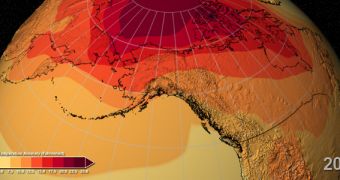A team of investigators from the NASA Goddard Institute for Space Studies (GISS) in New York determined in a recent study that our planet will most likely continue to get warmer throughout this century, despite the recent slowdown recorded over the past couple of years. The group says that earlier predictions remain valid, despite the small drop in average temperatures.
The reason why estimates were still deemed correct is very complex, but it has largely to do with the fact that previous measurements and predictions were based on weather data collected over the past 150 years. The new estimates include more recent data that better covers greenhouse gas emissions and other warming-promoting factors, which came into play more recently.
What the GISS group basically did was a more detailed calculation of just how sensitive our planet is to factors such as GHG emissions, cloud covers, aerosols, Arctic warming and sea ice melt, and so on. The team was led by GISS climatologist Drew Shindell. Based on the new data, the expert and his group determined that Earth will experience 20 percent more warming than previously believed.
Statistics show that average global temperatures have increased by around 0.12 degrees Celsius (0.22ºF) per decade since 1951. However, since 1998, this rate has decreased to just 0.05ºC (0,0ºF) per decade, prompting many to argue that global warming, as a trend, is abating. However, climatologists have already provided an explanation for why warming has subsided.
Scientists now believe that the El Niño atmospheric oscillation that occurred between 1997 and 1998 pumped massive amounts of heat out of the equatorial portions of the Pacific Ocean into the atmosphere. The ocean heat deficit this extreme event produced lasts to this day, cooling the climate.
In a paper published in the March 9 issue of the top journal Nature Climate Change, Shindell and his team calculate our planet's transient climate response (TCR), a measure of how temperatures will increase based on larger amounts of carbon dioxide being released into the atmosphere.
Recent research suggests a TCR range of 1.4ºC (2.52ºF), while the UN Intergovernmental Panel on Climate Change (IPCC) estimates a range of 1ºC (1.8ºF). The new GISS paper argues that Earth will most likely enter a TCR range of 1.3ºC (2.34ºF) over the next century.
“Working on the IPCC, there was a lot of discussion of climate sensitivity since it's so important for our future. The conclusion was that the lower end of the expected warming range was smaller than we thought before. That was a big discussion,” Shindell explains.
“Yet, I kept thinking, we know the Northern Hemisphere has a disproportionate effect, and some pollutants are unevenly distributed. But we don't take that into account. I wanted to quantify how much the location mattered,” adds the expert, who was the lead author of the IPCC Fifth Assessment Report's chapter on Anthropogenic and Natural Radiative Forcing.

 14 DAY TRIAL //
14 DAY TRIAL //